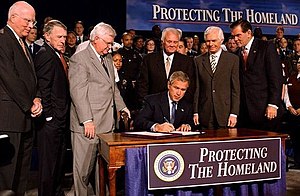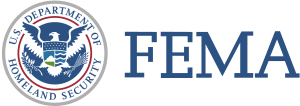by Elizabeth Hall
Introduction
 |
| English: Seal of the United States Department of Homeland Security. (Photo credit: Wikipedia) |
The Department of Homeland Security (DHS) arose from the ashes of the sites that received the terrible blow that foreign national terrorist group Al Qaeda dealt the United States on September 11, 2001. Americans awoke that morning, went to work as usual, but before the day or even morning was out we had lost over 3000 lives, including fire fighters, police officers, and the normal citizen working in the cities that were attacked. In the aftermath, the United States government went to work t
o establish the Department of Homeland Security. This new department is responsible for protecting the nation from attack, both abroad and at home, and we will discover the roles, missions, duties, responsibilities, formation, enabling legislation, and other newly created agencies that make up this department and the United States entered the Homeland Security era of policing (Oliver, 2007).
Role and Mission
Terrorist acts have been around for centuries, according to Oliver (2007), as the roots of terrorism began as far back as 1795, beginning with the French Reign of Terror, and were traditionally acts that people or groups committed against their government or ruling class. What made the September 11, 2001 attacks stand out is that they were the most brutal attacks ever committed against the United States on our homeland, and that, a foreign terrorist group made them successfully. Because of this action, the DHS was formed out of 22 formerly separate agencies in 2002 (DHS, 2002). Their role is to bridge the gap between agencies to bolster communications, response training, and as mentioned before to protect the nation from attack both at home and abroad. The mission of the DHS is actually made up of five directives. These are, preventing terrorism and enhancing the security of our nation, border security, enforcing immigration rules and regulations, secure cyberspace, and to ensure proper response to major attacks and natural disasters (DHS, n.d.).
 |
| WASHINGTON, DC - JUNE 09: Federal Emergency Management Agency (FEMA) Administrator Craig Fugate testifies before the Senate Banking, Housing and Urban Affairs Committee on Capitol Hill June 9, 2011 in Washington, DC. Fugate testified about the reauthorization of the National Flood Insurance Program. (Image credit: Getty Images via @daylife) |
Duties and Responsibilities
The DHS is the umbrella that all departments including law enforcement, fall under in the name of protecting our national interests both at home and abroad as reported by Oliver (2007). Because of the many duties, the DHS there are roles that each department must handle to ensure the smooth handling of emergencies due to natural disaster or attack. We will cover these duties and responsibilities per agency describing what each handles. According to Peak, (2009) the breakdown of duties and responsibilities looks like this:
Directorate for Preparedness- This office is responsible for protecting and guarding our “borders, seaports, bridges, and highways, along with “critical information systems”
Science and Technology Directorate– The department responsible for all research and technology development providing all levels, federal, state and local, with the technology needed to safeguard the country.
Management Directorate- This office is responsible for “budget and appropriations, expenditure of funds, accounting and finance, procurement, human resources, information technology systems, facilities and equipment, and identification and tracking of performance measurements”.
Office of Policy Directorate- This department is responsible for providing our long term planning strategies and policies to protect our nation from attack.
Federal Emergency Management Agency (FEMA) - The agency responsible for disaster response and recovery, National Flood Insurance Program, along with hazard preparedness and response.
Customs and Border Protection- Agency responsible for protecting our borders, which include 95,000 miles of shore and 7000 miles of shared border along Canada and Mexico. They also protect legitimate trades and business keeping the flow of imports and exports into the country particularly charged with keeping business running smoothly while keeping terrorists and their activity out of our country.
Immigration and Customs Enforcement (ICE) – The investigative force for the DHS, charged with finding and stopping our weak points in all areas including “borders, economic, transportation and infrastructure” for the nation. ICE works with both local law enforcement and intelligence agencies to shut down any vulnerability through four branches, Investigations, Detention and Removal, Protective Service, and Intelligence.
Office of Intelligence and Analysis – Agency is responsible for analyzing gathered
intelligence from a multitude of sources that assesses the current and upcoming credible threats to the country.
Office of Operations Coordination – Operations between all 50 states and 50 metropolitan areas in the country including all DHS offices, law enforcement, governors, and operators of critical infrastructure facilities in the United States are coordinated on a daily basis through this department.
Domestic Nuclear Detection Office- Agency charged with the improvement of early detection of nuclear threats through all levels, local, state, federal, and tribal.
Transportation Security Administration (TSA) – This agency is designed to protect our transportation systems including airports, rail cars, subways, collaborating with law enforcement, and Federal Air Marshals, including canines and explosives experts, along with armed officers.
Federal Law Enforcement Training Center - Agency that serves as a training organization for law enforcement at all levels of government, ensuring that they are trained with the latest safety and protection information available.
Citizenship and Immigration Services – Agency concerned with immigration policy and naturalization procedure for the nation.
Coast Guard - Agency providing protection for our ports and waterways in all areas needed to protect the nation both at home and in international waters.
Secret Service – Presidential and Ranking Officials agency ensuring the safety of our leadership, the Secret Service also investigates financial crimes like counterfeiting, computer based crimes, and computer based attacks on our country.
It is under this large umbrella that our entire nation operates to secure our citizens from attacks from persons or groups who wish to harm our country both domestically and internationally (Peak, 2009).
Formation
Oliver (2007) holds that the Department of Homeland Security may have been created in 2002, but the notion of national security against terrorism has been around since the Founding Fathers, based on the Constitution of the United States, Article 4 Section 4. The difference is that the Federal Government took a backseat on the issue unless the State’s own resources for defense were completely overpowered. Federal authority came in the three forms, when incidences occurred, threatening our national unity, national security when involving foreign nations, and violations of federal laws passed by Congress. Since the 9/11 attacks, we have passed legislation enabling the Federal Government to intervene in the interest of national security on many more levels (Oliver, 2007).
Enabling Legislation
 |
| President George W. Bush signs the Homeland Security Appropriations Act of 2004 on October 1, 2003. (Photo credit: Wikipedia) |
Ever since the 1803 disaster where there was a large fire in Portsmouth NH, Congress has had the ability to write legislation allowing for further intervention by the Federal Government (Oliver, 2007). Most of this legislation involves natural disasters or fabricated disasters like the 1871 fire in Chicago or domestic disturbances like the Whiskey Rebellion. As far as security for the homeland, there was no real need until after WWI, however this was not really ever considered a real threat until now, as it was largely believed that no one could reach us. The one thing that was put into legislation is the U.S. Army Appropriations Act which then in turn spawned the Council of National Defense both which were gone by 1921 Oliver, 2007)..
These laws were followed in the 1930’s with the creation of the National Security Council according to Oliver (2007). Just before entry in WWII, the National Security Council was renamed the Office of Emergency Management, and the Office of Civil Defense was created. In 1947, the National Security Resources Board was created, along with the Office of Civil Defense Planning, and Executive Order 10186. From this the Federal Civil Defense Administration was created to be a non federal agency charged with coordination of the country’s defense which was important now because the Soviet Union had tested nuclear weapons by this time.
 |
| Federal Emergency Management Agency (Photo credit: Wikipedia) |
The 1960’s and 1970’s, brought many different agencies and titles, but the only one left that made it to the current decade is FEMA. FEMA stands for Federal Emergency Management Agency, and is still in existence today, falling under the Department of Homeland Security (Oliver, 2007). The Department of Homeland Security was created in 2003 after the Patriot Act of 2001, and the Homeland Security Act of 2002, because of the 9/11 attacks and the realization that FEMA needed to be expanded in order to effectively protect the homeland. Oliver (2007) notes that FEMA is now governed under the DHS instead of over it even though it has been around since the late 1970’s.
References:
Department of Homeland Security (DHS), (2002). History. Retreived From: http://www.dhs.gov/history
Department of Homeland Security (DHS), (n.d.). Our Mission: Overview. Retreived From: http://www.dhs.gov/our-mission
Oliver, W.M., (2007). Homeland Security for Policing. Pearson Education. Prentice Hall.
Peak, K.J., (2009). Policing America: Challenges and Best Practices. Upper Saddle River NJ. Pearson Education Inc. ISBN: 0-13-159803-1


















0 comments:
Post a Comment